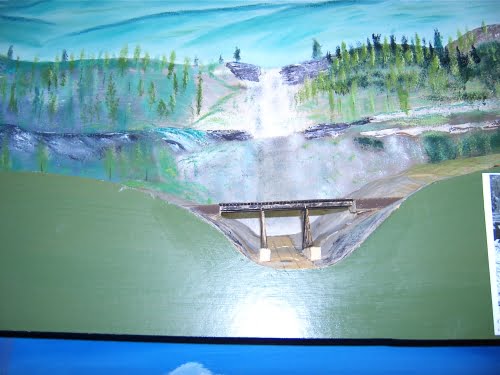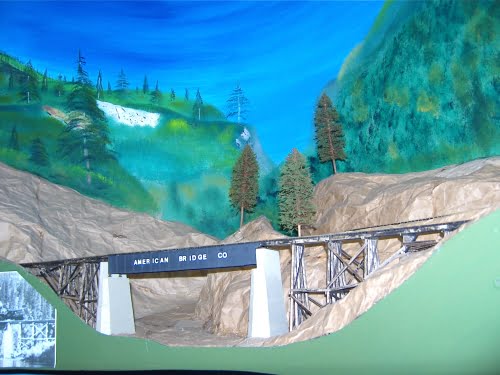Sierra Railroad 1955
Pickering Lumber Corp
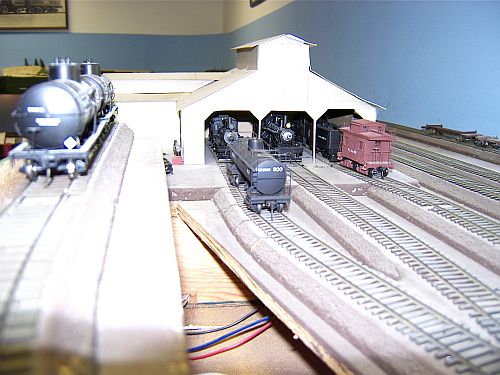
The Pickering engine house at Fassler. The Fassler local switcher, Heisler #4, a two truck Heisler is in the middle stall of the engine house. The mill engine, the three truck Heisler #1 in the right hand stall, will make two trips up to Schoettgen Pass taking empties up the hill and bringing down loads to the mill.
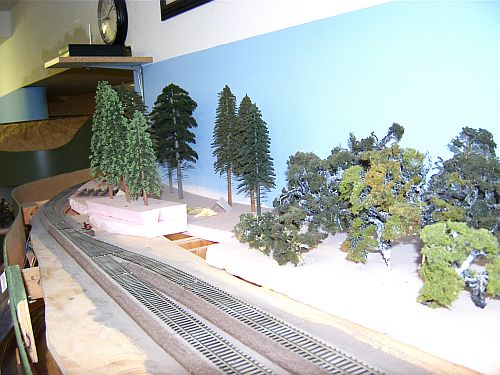
The Pickering heading towards Schoettgen Pass from Ralph. Just below the clock on the wall is the radio throttle receiver that covers all the layout. In the background is the beginning of the Peeled Onion.
Schoettgen Pass. The Woods Train with its loaded log cars will meet the Mill Train and its empties from Fassler. The trains exchange cars with the Mill training returning to Fassler with the loaded log cars. The Woods train will return to Beardsley Flat to pick up the loaded log cars it had dropped there earlier and then will return to Schoettgen Pass for another meet with the Mill Train. (12-09)
The beginning of the Peeled Onion, a shear granite ledge that railroad cut a shelf into so they could descend into the Stanislaus River canyon. (12-09)
Another shot of the Peeled Onion (12-09)
The Peeled Onion looking east up the Stanislaus River Canyon towards Beardsley Flat. (12-09)
The track crossing over the aisle is the WSLCo mainline heading towards the River Bridge in the Tuolumne River canyon. The Pickering runs under the WSLCo and continues along the wall. In the corner you can see the Pickering bridge over the Stanislaus River. (12-09)
January 2011 – the Pickering mainline crossing over the PG &E incline running up the hill to Spring Gap. When the scene is completed there will bo Code 40 rail running under the trestle along with a cable for lowering and raising cars on the incline. Compare this photo with the one below.
The Pickering crossing over PG &E incline that ran from Spring Gap down to the River. (12-09)
January 2011 – the bridge over the Stanislaus River at Beardsley Flat. The trestle bents have been added. The spur at Beardsley Flat has also been re-aligned. It now runs through a cut on the hillside instead of disappearing into a cut.
The Pickering Bridge over the Stanislaus River. Once the Beardsley Dam was built this area was under water. The next project is to finish the trestle approaches to the bridge and the scenery base around the bridge. There is a great picture of this bridge on the back cover of Manny Marshall’s book.(12-09)
As the Pickering starts to climb out of the canyon on the north side of the river it crosses Chinaman’s Creek on the trestle.(12-09)
The Pickering heading east towards Soap Creek’s logging camp.(12-09)
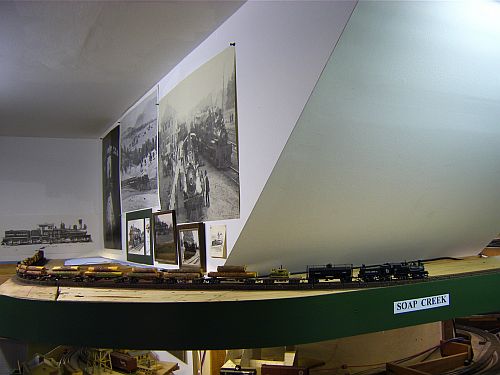
Soap Creek, the end of the line for the Pickering. Soap Creek was a reload location for the railroad by the 1950’s. For now its only a single track staging track and the starting point of the Woods train run to Schoettgen Pass. At some point there will be additional trackage and scenery but there will be no local switching during the Op Session because it is too high for convenient access.
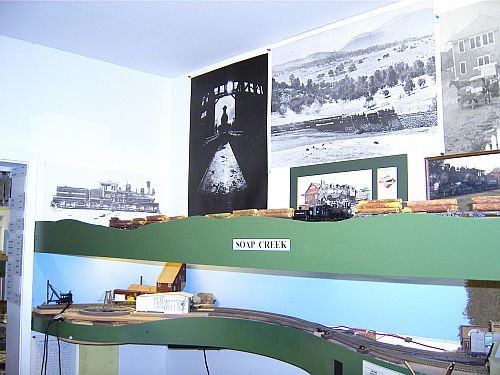
In this view of Soap Creek you can see the mid train helper, both engines are Bachmann Shays, and the caboose at the end of the train.
Railroad Pages
- Welcome
- About the Layout
- What's New
- Operations Overview
- Photos
- Prototype Track Drawings
- Contact/Location
- Research Sources
- Sierra Railroad Op Session Calendar
Sierra Historical & Modeling Seminar
Recent Posts
Post Archives
- August 2007 (1)
- May 2007 (1)
Post Categories
- Announcements (2)
Historical Groups
Model Mfgs
Operations
Other Layout Links
Other Sites
Meta
copyright © 2007-2025 John Zach -- WP-Design: Vlad -- Powered by WordPress -- site by webdancers
